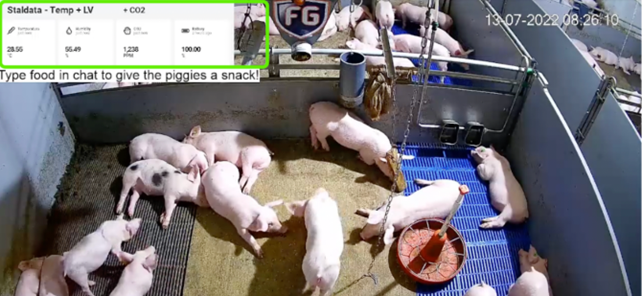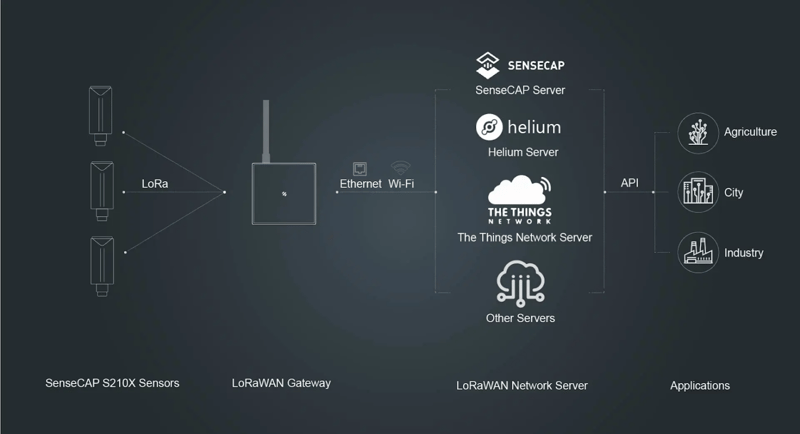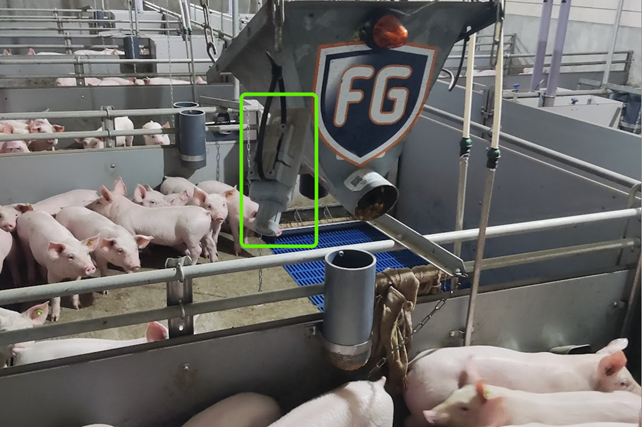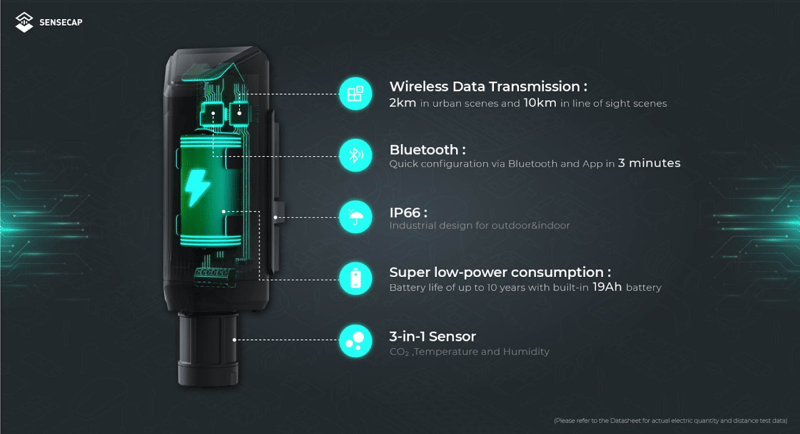27 October, 2022 3 min read
「集中養豚システム」としても知られる集中養豚は、養豚産業における主要な養豚方法となっています。この方法では、豚は高い飼育密度で個別の小屋または藁を敷いた小屋に閉じ込められて屋内飼育され、同時に、同年齢の豚が共通の環境設定の下で大規模な群れとして生活する状態が保たれます。これにより、給餌効率が大幅に向上します。豚の健康を維持し、豚の成長を保護するために新技術が頻繁に採用されていますが、ワイヤレス温湿度センサーを使用した納屋内のさまざまな環境パラメーターの監視は、その好例です。
In the Netherlands, for environmental reasons, air scrubbers are deployed on most farms, and all the air is sucked out of the barn through a central ventilation chamber and is scrubbed before going outside, to prevent ammonia pollution in the environment. The barns are mostly closed with no access from the outside. Therefore, local farmers cannot monitor every pig and must rely on technology to make sure the conditions in every barn are constant. To address this challenge with increased transparency and accuracy, Stal Data decided to livestream the living conditions of pigs through monitoring diverse environmental parameters with Seeed Studio’s SenseCAP environmental sensors utilizing the LoRaWAN® standard. (Figure 1).
 Figure 1. Pig Barn Being Livestreamed in the Netherlands
Figure 1. Pig Barn Being Livestreamed in the Netherlands
ⓒ Stal Data
Based in the Netherlands, Stal Data is a technology solutions company that focuses on improving the well-being of pigs by monitoring animal behaviors and their living environment. By utilizing SenseCAP sensors to build a LoRaWAN network in the farm, it can monitor different environmental conditions of pig farms.
How does this work? Stal Data builds the LoRaWAN network in only 3 steps (Figure 2):
Deploy a gateway leveraging LoRaWAN connectivity
Deploy SenseCAP S210x environmental sensors utilizing LoRaWAN to collect and analyze data
Visualize data analytics on the web and SenseCAP Mate App
 Figure 2. SenseCAP Solutions Using LoRaWAN
Figure 2. SenseCAP Solutions Using LoRaWAN
ⓒ Seeed Studio
The gateway using LoRaWAN is featured with the ability to communicate and operate over long distances (up to 10km of LoRaWAN coverage). In addition to ultra-low power consumption (sensors’ battery life of up to 10 years), the LoRaWAN standard enables the devices with easy and wireless deployment, thus helping farmers significantly reduce the deployment cost.
Monitoring temperature and humidity is important in pig farming scenarios because it helps farmers to understand what is going on with the climate inside the pig barns (Figure 3). As an example, Stal Data observed the air was very hot and humid in the rear room of the barns. It placed 12 temperature and humidity sensors using LoRaWAN inside the room. By measuring the temperature and humidity, it found out that the temperature in the rear end of the room was always 5 degrees higher than the front end of the room - where the air gets sucked out of the room. After learning this insight, Stal Data placed an extra air ventilator in the rear end of the room to circulate the air to the front end of the room. In this way, the temperature can be maintained at an almost equal level.
By measuring CO2 concentration level, Stal Data can check the minimum ventilation level for the ventilation system. The minimum ventilation level must be set so that the CO2 concentration level never exceeds 3000ppm CO2. When it reaches 3000ppm CO2, the minimum ventilation percentage must be set to be higher. Furthermore, when the concentration is higher in the front end of the room than in the rear end, it signifies that the front end does not obtain as much clean air as the rest of the room with a lower CO2 concentration level. In this way, it can check if the air is distributed equally across the room in the barn.
Another important environmental measurement needed for sound pig growth is ammonia (NH3) concentration level because it is very irritating to the mucous membranes of pigs. Ideally, for piglets, the concentration should be lower than 8ppm ammonia. However, if the pigs reach 30 kilos, the concentration level should be lower than 15ppm ammonia. By deploying NH3 sensors utilizing LoRaWAN inside the barns, Stal Data gets real-time, accurate data on the ammonia concentration level to take preventative measures before it exceeds the ideal threshold.
 Figure 3. CO2, Temperature, and Humidity Wireless Sensors Using LoRaWAN
Figure 3. CO2, Temperature, and Humidity Wireless Sensors Using LoRaWAN
Inside Stal Data’s Pig Barn
ⓒ Stal Data
Integrating Semtech’s LoRa® devices, SenseCAP has launched comprehensive solutions from the end to the Cloud, supporting end users to build Internet of Things (IoT) applications (Figure 4). As the wireless platform of choice for IoT, LoRa connects sensors to the Cloud and enables real-time communication of data and analytics that can be utilized to enhance efficiency, productivity and sustainability.
At this time, a series of SenseCAP S210x environmental sensors using LoRaWAN are available to support a wide range of industrial applications like precision farming, smart city, wildlife conservation, and more. Together with SenseCAP Mate APP, end users can finish the deployment in a matter of minutes, and get real-time data simultaneously.
 Figure 4. Architecture of SenseCAP S210x Environmental Sensors With LoRaWAN
Figure 4. Architecture of SenseCAP S210x Environmental Sensors With LoRaWAN
ⓒ Seeed Studio
To learn more about SenseCAP’s devices using LoRa, explore them all here。
Semtech®, the Semtech logo, LoRa®, and LoRaWAN® are registered trademarks or service marks of Semtech Corporation or its affiliates. Other product or service names mentioned herein may be the trademarks of their respective owners.
イノベーションを受信トレイにお届けします。当社のブログに登録して、Semtechの最新情報を入手してください。